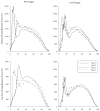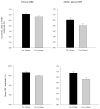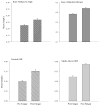Differential effects of fatigue on movement variability
- PMID: 24370441
- PMCID: PMC3960345
- DOI: 10.1016/j.gaitpost.2013.11.020
Differential effects of fatigue on movement variability
Abstract
When individuals perform purposeful actions to fatigue, there is typically a general decline in their movement performance. This study was designed to investigate the effects exercise-induced fatigue has on lower limb kinetics and kinematics during a side-step cutting task. In particular, it was of interest to determine what changes could be seen in mean amplitude and all metrics of signal variability with fatigue. The results of the study revealed that post-fatigue there was an overall decrease in absolute force production as reflected by a decline in mean amplitude and variability (SD) of the ground reaction forces (GRFV and GRFML). A decrease in mean and SD of the knee moments were also observed post-exercise. Interestingly, this trend was not mirrored by similar changes in time-dependent properties of these signals. Instead, there was an increase in the SampEn values (reflecting a more variable, irregular signal) for GRF force profiles, knee kinematics and moments following the exercise-induced fatigue. These results illustrate that fatigue can have differential effects on movement variability, resulting in a both an increase and decrease in movement variability, depending on the variable selected. Thus, the impact of fatigue is not simply restricted to a decline in force producing capacity of the system but more importantly it demonstrates that the ability of the person to perform a smooth and controlled action is limited due to fatigue.
Keywords: Complexity; Gait; Lower extremity; Sample entropy.
Copyright © 2013 Elsevier B.V. All rights reserved.
Figures



Similar articles
-
Fatigue alters the biomechanical contribution of lower extremity joints during a stretch-shortening cycle task.Acta Bioeng Biomech. 2019;21(2):11-19. Acta Bioeng Biomech. 2019. PMID: 31741477 Clinical Trial.
-
Alterations to landing technique and patellar tendon loading in response to fatigue.Med Sci Sports Exerc. 2014 Feb;46(2):330-40. doi: 10.1249/MSS.0b013e3182a42e8e. Med Sci Sports Exerc. 2014. PMID: 23852266
-
Slow-time changes in human EMG muscle fatigue states are fully represented in movement kinematics.J Biomech Eng. 2009 Feb;131(2):021004. doi: 10.1115/1.3005177. J Biomech Eng. 2009. PMID: 19102563 Free PMC article.
-
Upper extremity kinematic and kinetic adaptations during a fatiguing repetitive task.J Electromyogr Kinesiol. 2014 Jun;24(3):404-11. doi: 10.1016/j.jelekin.2014.02.001. Epub 2014 Feb 13. J Electromyogr Kinesiol. 2014. PMID: 24642235 Clinical Trial.
-
The stretch-shortening cycle : a model to study naturally occurring neuromuscular fatigue.Sports Med. 2006;36(11):977-99. doi: 10.2165/00007256-200636110-00004. Sports Med. 2006. PMID: 17052133 Review.
Cited by
-
Effects of prolonged walking with body borne load on knee adduction biomechanics.Gait Posture. 2021 Feb;84:192-197. doi: 10.1016/j.gaitpost.2020.12.004. Epub 2020 Dec 17. Gait Posture. 2021. PMID: 33360641 Free PMC article.
-
Kinetic analysis of change of direction simulating a defensive action in soccer players with and without acute fatigue.Heliyon. 2024 Nov 7;10(22):e40213. doi: 10.1016/j.heliyon.2024.e40213. eCollection 2024 Nov 30. Heliyon. 2024. PMID: 39624301 Free PMC article.
-
Comparison of Mean Values and Entropy in Accelerometry Time Series from Two Microtechnology Sensors Recorded at 100 vs. 1000 Hz During Cumulative Tackles in Young Elite Rugby League Players.Sensors (Basel). 2024 Dec 11;24(24):7910. doi: 10.3390/s24247910. Sensors (Basel). 2024. PMID: 39771647 Free PMC article.
-
Shoes with active insoles mitigate declines in balance after fatigue.Sci Rep. 2020 Feb 6;10(1):1951. doi: 10.1038/s41598-020-58815-9. Sci Rep. 2020. PMID: 32029789 Free PMC article.
-
Dynamical complexity of postural control system in autism spectrum disorder: a feasibility study of linear and non-linear measures in posturographic analysis of upright posture.J Neuroeng Rehabil. 2024 Dec 23;21(1):225. doi: 10.1186/s12984-024-01520-9. J Neuroeng Rehabil. 2024. PMID: 39710690 Free PMC article.
References
-
- Enoka RM, Stuart DG. Neurobiology of muscle fatigue. Journal Of Applied Physiology (Bethesda, Md: 1985) 1992;72(5):1631–1648. - PubMed
-
- Gandevia SC. Spinal and supraspinal factors in human muscle fatigue. Physiological Reviews. 2001;81(4):1725–1789. - PubMed
-
- Morrison S, et al. The effects of unilateral muscle fatigue on bilateral physiological tremor. Experimental Brain Research. 2005;167:609–621. - PubMed
-
- Enoka RM, et al. Task- and age-dependent variations in steadiness. Progress In Brain Research. 1999;123:389–395. - PubMed
-
- Missenard O, Mottet D, Perrey S. Muscular fatigue increases signal-dependent noise during isometric force production. Neuroscience Letters. 2008;437(2):154–157. - PubMed
Publication types
MeSH terms
Grants and funding
LinkOut - more resources
Full Text Sources
Other Literature Sources

